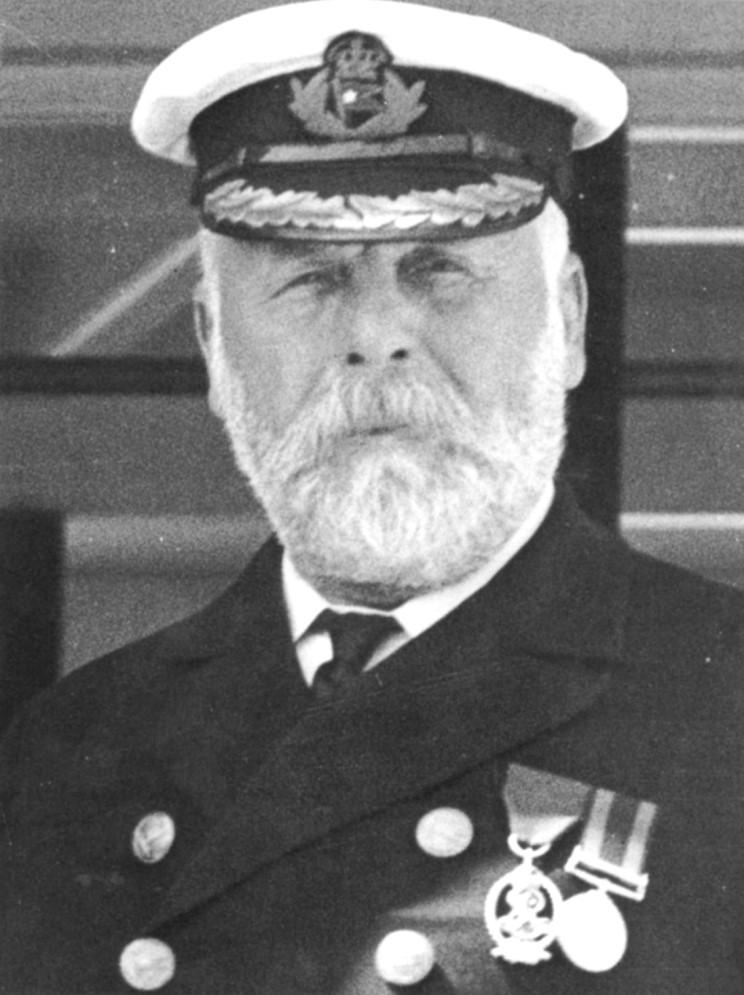WHO WAS CAPTAIN SMITH AND WHAT WAS HIS ROLE IN THE SINKING OF THE TITANIC?

Captain Edward Smith is most famous for his role at the helm of the Titanic, the disastrous last voyage in his successful career at sea. Rumors about Captain Smith and his final hours have circulated since that fateful night, leading many to blame the captain for the sinking of the ship. Let’s explore who Edward Smith was before commanding the Titanic and if he is at fault in the sinking of the ship.
Captain Smith’s Career At Sea

Edward Smith was born the son of a potter on January 27th, 1850 in Hanley, Staffordshire, England. Hanley is now Stoke-on-Trent, home of Wedgwood china. Like many children of working-class backgrounds, Smith left school early—around the age of 12–and started his life as a sailor when he was a teenager, signing on to the crew of the Senator Weber in 1867.[1] In the years to come, Smith continued to work his way up the ranks, earning his certificate as a second mate in 1871, first mate in 1873, and master in 1875.[2]
In 1880, Smith made the jump from commercial shipping to passenger ships when he was hired as a junior officer with the White Star Line. In 1887, he commanded his first ship, the Baltic.[3] That same year, he also married Eleanor Pennington. In 1902, the couple’s only child, a daughter named Helen, was born.[4]
Over the course of his career, Smith earned a reputation for being popular with both crew and passengers. In fact, he was dubbed “the Millionaire’s Captain” because he was so well-liked by wealthy travelers.[5] In fact, Margaret had traveled with him previously, and dined with him on the Olympic. After many years at sea and serving in the Boer War, Smith became the senior captain of the White Star Line. Held in high esteem, Captain Smith also had particular experience with commanding especially large ships. In 1904, the White Star Line, just purchased by the International Mercantile Marines, added a new Baltic to their fleet. The ship weighed 23,876 tons and was one of the largest ships at that time. After the Baltic, Smith commanded the Adriatic, which was 24,541 tons.[6] For reference, the Titanic weighed 46,328 tons.
Smith’s career was not without mishaps, however. For example, in 1911 he was the captain of the Olympic when it was extensively damaged in a collision with the British cruiser Hawke. On several occasions, Smith’s ships ran aground.[7] No career is without mishaps, though, and Smith’s reputation as a captain was not tarnished by these incidents.[8] After commanding the Titanic on her maiden voyage, Captain Smith was supposed to retire.
What Role Did Captain Smith Play in the Sinking of the Titanic?
After the sinking of the Titanic, rumors swirled about the ship, the passengers, and the events that led to the tragedy. Among these rumors were tales that Captain Smith faced pressure from the White Star Line to keep up the ship’s speed, or that he ignored warnings from other ships about the presence of icebergs. In fact, after the disaster, both the United States and the United Kingdom launched inquiries to determine whether or not the White Star Line was liable for damages related to loss of life and property. Among the important questions these inquiries investigated were what role speed and ice warnings played in the accident.[9]
Regarding the ship’s speed, the prevailing story has become that the Titanic was traveling too fast and, had Captain Smith slowed the ship down, the accident could have been averted. The commissions were particularly interested in whether J. Bruce Ismay, the managing director of the White Star Line, put pressure on Smith to maintain the ship’s speed. The evidence showed that, although the Titanic was going fast, it never reached top speed. Furthermore, the night was clear and the water calm. Captain Smith directed the crew to slow down if there was any haze or fog. The British Inquiry concluded that Captain Smith commanded the ship according to the best practices for a captain with his experience, but perhaps those practices should change:
“The evidence shows that he was not trying to make any record passage or indeed any exceptionally quick passage. He was not trying to please anybody, but was exercising his own discretion in the way he thought best. He made a mistake, a very grievous mistake, but one in which, in face of the practice and of past experience, negligence cannot be said to have had any part; and in the absence of negligence it is, in my opinion, impossible to fix Captain Smith with blame.”[10]
Questions also lingered about whether or not Captain Smith ignored warnings from other ships about the presence of ice. According to Fourth Officer Joseph Boxhall, he and Captain Smith plotted the coordinates of early ice warnings and were aware of the presence of ice in their general path. Later warnings, however, never left the telegraph room because the Marconi system was overwhelmed.[11]
Captain Smith in Titanic Mythology
Some of the myths about Captain Smith and the Titanic originated from survivors themselves. Several eyewitnesses testified that they saw Captain Smith rescue a drowning infant before swimming back to the sinking ship to meet his fate.[12]
Others testified that they witnessed Captain Smith take his own life with a pistol as the ship was sinking, but the general consensus was that this was not true. Rather, the majority of accounts report Captain Smith diving off the bridge into the water as the ship sank.[13]
Similarly, there is some dispute about Captain Smith’s final words. Several members of the crew report Smith encouraging his crew to act honorably, extolling them to, “Be British!”[14] Those who worked most closely alongside Smith during the sinking reported that he instructed the remaining crew to do what they could for the women and children and look out for themselves before he returned to the bridge to go down with the ship.
It is this final act of leadership that has become the most enduring image of Captain Smith. While we cannot know for sure how he spent his final moments, it is known that Captain Edward Smith perished in the North Atlantic along with 1517 others on April 15, 1912. His body was never recovered.
By: Kasey Butcher Santana, Molly Brown House Volunteer
References:
[1] “Edward J. Smith.” Biography.com, A&E Networks Television, 2 Aug. 2019, www.biography.com/amp/historical-figure/Edward-j-smith.
[2] “Edward J. Smith.” Biography.com, A&E Networks Television, 2 Aug. 2019, www.biography.com/amp/historical-figure/Edward-j-smith.
[3] Tikkanen, Amy. “Edward J. Smith.” Encyclopedia Britannica, Encyclopedia Britannica, Inc., 23 Jan. 2020, www.britannica.com/biography/Edward-J-Smith.
[4] “Edward J. Smith.” Biography.com, A&E Networks Television, 2 Aug. 2019, www.biography.com/amp/historical-figure/Edward-j-smith.
[5] Tikkanen, Amy. “Edward J. Smith.” Encyclopedia Britannica, Encyclopedia Britannica, Inc., 23 Jan. 2020, www.britannica.com/biography/Edward-J-Smith.
[6] “Edward J. Smith.” Biography.com, A&E Networks Television, 2 Aug. 2019, www.biography.com/amp/historical-figure/Edward-j-smith.
[7] Tikkanen, Amy. “Edward J. Smith.” Encyclopedia Britannica, Encyclopedia Britannica, Inc., 23 Jan. 2020, www.britannica.com/biography/Edward-J-Smith.
[8] Compton, Nic. Titanic on Trial: the Night the Titanic Sank Told through the Testimonies of Her Passengers and Crew. Bloomsbury Publishing, 2012.
[9] Compton, Nic. Titanic on Trial: the Night the Titanic Sank Told through the Testimonies of Her Passengers and Crew. Bloomsbury Publishing, 2012.
[10] Compton, Nic. Titanic on Trial: the Night the Titanic Sank Told through the Testimonies of Her Passengers and Crew. Bloomsbury Publishing, 2012.
[11] Compton, Nic. Titanic on Trial: the Night the Titanic Sank Told through the Testimonies of Her Passengers and Crew. Bloomsbury Publishing, 2012.
[12] Everett, Marshall. Wreck and Sinking of the Titanic. Forgotten Books, 2016.
[13] Heyer, Paul. Titanic Century: Media, Myth, and the Making of a Cultural Icon. Praeger, 2012.
[14] Everett, Marshall. Wreck and Sinking of the Titanic. Forgotten Books, 2016.
